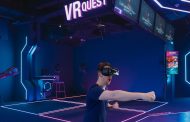Free science education software, available to anyone with virtual reality gear, holds promise for spreading awareness and inspiring action on the pressing issue of ocean acidification.
Try to imagine what the world will look like if human-caused carbon-dioxide emissions aren’t curbed. If your imagination and scientific knowledge can’t take you there, virtual reality can. The Stanford Ocean Acidification Experience, a free science education tool (download here), can take you to the bottom of the sea, then fast-forward to the end of the century, when many coral reefs are predicted to corrode in waters made acidic by the absorption of carbon dioxide from the atmosphere.
“You’re not watching something, you’re doing it,” said communication Professor Jeremy Bailenson, whose Virtual Human Interaction Lab developed the software. “You learn by doing. These are magic, teachable moments.”
Although a dire threat to coral and other marine systems that provide food and employment for hundreds of millions of people, ocean acidification is not a well-known phenomenon. Coral reefs are particularly vulnerable to acidification’s effects on the building of calcium carbonate skeletons and shells.





